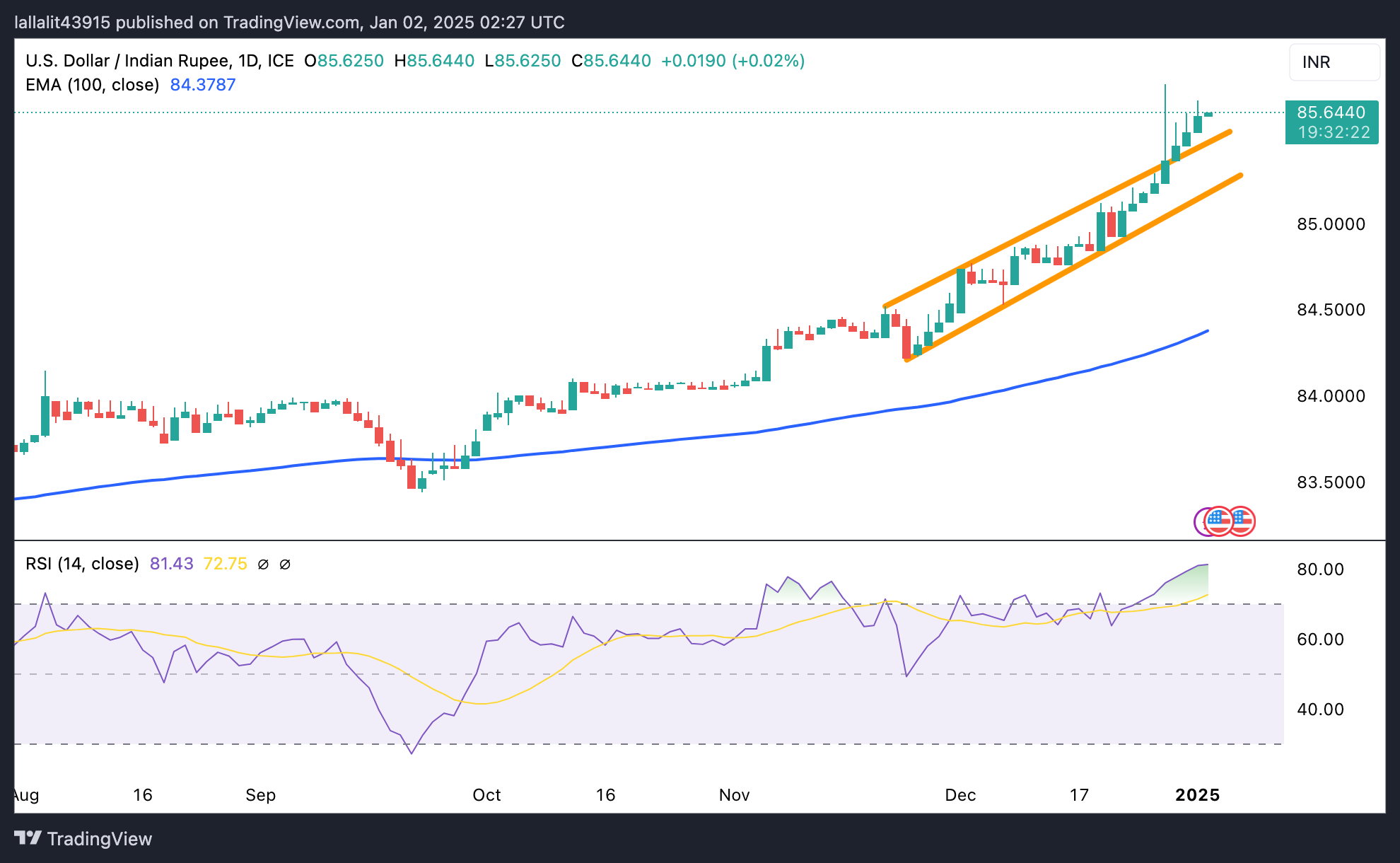- The Indian Rupee softens in Thursday’s Asian session.
- USD bids from importers and subdued overseas inflows proceed to undermine the INR.
- Traders brace for India’s December HSBC Manufacturing PMI and the US weekly Preliminary Jobless Claims.
The Indian Rupee (INR) stays weak on Thursday. The explanations attributed to the weakening within the native foreign money are a rise in demand for US Greenback (USD) from importers, the next 10-year US Treasury yield and issues about India’s slowing financial development.
Then again, the draw back for the INR is likely to be restricted because the Reserve Financial institution of India (RBI) will seemingly proceed to intervene within the foreign money market to curb volatility. Afterward Thursday, India’s HSBC Manufacturing Buying Managers Index (PMI) for December is due. On the US docket, the weekly Preliminary Jobless Claims and S&P International Manufacturing PMI for December can be revealed.
Indian Rupee stays fragile amid importer USD bids and home elements
- “The rupee remains to be inclined to downward stress, given sturdy greenback bids and sturdy US yields,” mentioned Anil Kumar Bhansali, Head of Treasury at Finrex Treasury Advisors LLP.
- In line with Reuters, the bearish bias of the INR is pushed by a mix of things, together with the Dollar sustaining its power close to 108.48 and chronic issues over slowing home development and a widening commerce deficit.
- India’s fiscal deficit for the April-November interval of FY25 stood at 8.47 trillion rupees ($98.90 billion), or 52.5% of the estimate for the monetary yr, based on official information launched on Tuesday. The fiscal deficit widened from 50.7% reported within the comparable year-earlier interval.
- The true GDP development is estimated at 6.6% for 2024-25, and 6.9% for the primary quarter of 2025-26, as per the Reserve Financial institution of India (RBI).
- The US Housing Value Index rose 0.4% MoM in October versus 0.7% prior, based on the Federal Housing Finance Company. This studying got here in weaker than the 0.5% anticipated.
- The US S&P/Case-Shiller Dwelling Value Indices climbed 4.2% YoY in October, in comparison with 4.6% within the earlier studying, beating the estimation of 4.1%.
USD/INR maintains a constructive tone regardless of the overbought RSI situation
The Indian Rupee trades in unfavourable territory on the day. Technically, the USD/INR broke above the ascending development channel over the previous week. The constructive view of the pair prevails as the value holds above the important thing 100-day Exponential Transferring Common (EMA) on the every day timeframe. Nonetheless, the 14-day Relative Power Index (RSI) studying above 70 suggests an overbought situation and indicators that additional consolidation can’t be dominated out earlier than positioning for any near-term USD/INR appreciation.
The all-time excessive of 85.81 acts as a right away resistance stage for USD/INR. If bulls handle to interrupt above this stage, then a transfer to the 86.00 psychological stage might be in play within the quick time period.
On the flip aspect, the primary draw back goal is seen on the resistance-turned-support stage of 85.50. A breach of the talked about stage may attract sellers to 85.00, the spherical determine, en path to the 100-day EMA at 84.37.

Indian Rupee FAQs
The Indian Rupee (INR) is without doubt one of the most delicate currencies to exterior elements. The worth of Crude Oil (the nation is extremely depending on imported Oil), the worth of the US Greenback – most commerce is carried out in USD – and the extent of overseas funding, are all influential. Direct intervention by the Reserve Financial institution of India (RBI) in FX markets to maintain the alternate fee secure, in addition to the extent of rates of interest set by the RBI, are additional main influencing elements on the Rupee.
The Reserve Financial institution of India (RBI) actively intervenes in foreign exchange markets to take care of a secure alternate fee, to assist facilitate commerce. As well as, the RBI tries to take care of the inflation fee at its 4% goal by adjusting rates of interest. Greater rates of interest often strengthen the Rupee. That is because of the function of the ‘carry commerce’ wherein traders borrow in nations with decrease rates of interest in order to put their cash in nations’ providing comparatively increased rates of interest and revenue from the distinction.
Macroeconomic elements that affect the worth of the Rupee embrace inflation, rates of interest, the financial development fee (GDP), the stability of commerce, and inflows from overseas funding. A better development fee can result in extra abroad funding, pushing up demand for the Rupee. A much less unfavourable stability of commerce will ultimately result in a stronger Rupee. Greater rates of interest, particularly actual charges (rates of interest much less inflation) are additionally constructive for the Rupee. A risk-on atmosphere can result in better inflows of International Direct and Oblique Funding (FDI and FII), which additionally profit the Rupee.
Greater inflation, significantly, whether it is comparatively increased than India’s friends, is usually unfavourable for the foreign money because it displays devaluation by oversupply. Inflation additionally will increase the price of exports, resulting in extra Rupees being bought to buy overseas imports, which is Rupee-negative. On the similar time, increased inflation often results in the Reserve Financial institution of India (RBI) elevating rates of interest and this may be constructive for the Rupee, because of elevated demand from worldwide traders. The alternative impact is true of decrease inflation.
